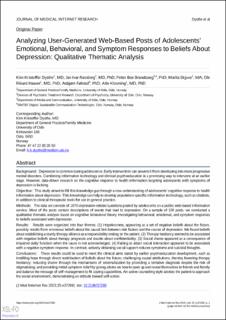| dc.contributor.author | Dysthe, Kim Kristoffer | |
| dc.contributor.author | Røssberg, Jan Ivar | |
| dc.contributor.author | Brandtzæg, Petter Bae | |
| dc.contributor.author | Skjuve, Marita | |
| dc.contributor.author | Haavet, Ole Rikard | |
| dc.contributor.author | Følstad, Asbjørn | |
| dc.contributor.author | Klovning, Atle | |
| dc.date.accessioned | 2023-09-18T13:21:32Z | |
| dc.date.available | 2023-09-18T13:21:32Z | |
| dc.date.created | 2023-02-19T14:02:44Z | |
| dc.date.issued | 2023 | |
| dc.identifier.citation | Journal of Medical Internet Research. 2023, 25, e37289. | en_US |
| dc.identifier.issn | 1438-8871 | |
| dc.identifier.uri | https://hdl.handle.net/11250/3090153 | |
| dc.description.abstract | Background: Depression is common during adolescence. Early intervention can prevent it from developing into more progressive mental disorders. Combining information technology and clinical psychoeducation is a promising way to intervene at an earlier stage. However, data-driven research on the cognitive response to health information targeting adolescents with symptoms of depression is lacking.
Objective: This study aimed to fill this knowledge gap through a new understanding of adolescents’ cognitive response to health information about depression. This knowledge can help to develop population-specific information technology, such as chatbots, in addition to clinical therapeutic tools for use in general practice.
Methods: The data set consists of 1870 depression-related questions posted by adolescents on a public web-based information service. Most of the posts contain descriptions of events that lead to depression. On a sample of 100 posts, we conducted a qualitative thematic analysis based on cognitive behavioral theory investigating behavioral, emotional, and symptom responses to beliefs associated with depression.
Results: Results were organized into four themes. (1) Hopelessness, appearing as a set of negative beliefs about the future, possibly results from erroneous beliefs about the causal link between risk factors and the course of depression. We found beliefs about establishing a sturdy therapy alliance as a responsibility resting on the patient. (2) Therapy hesitancy seemed to be associated with negative beliefs about therapy prognosis and doubts about confidentiality. (3) Social shame appeared as a consequence of impaired daily function when the cause is not acknowledged. (4) Failing to attain social interaction appeared to be associated with a negative symptom response. In contrast, actively obtaining social support reduces symptoms and suicidal thoughts.
Conclusions: These results could be used to meet the clinical aims stated by earlier psychoeducation development, such as instilling hope through direct reattribution of beliefs about the future; challenging causal attributions, thereby lowering therapy hesitancy; reducing shame through the mechanisms of externalization by providing a tentative diagnosis despite the risk of stigmatizing; and providing initial symptom relief by giving advice on how to open up and reveal themselves to friends and family and balance the message of self-management to fit coping capabilities. An active counseling style advises the patient to approach the social environment, demonstrating an attitude toward self-action. | en_US |
| dc.language.iso | eng | en_US |
| dc.publisher | JMIR | en_US |
| dc.rights | Navngivelse 4.0 Internasjonal | * |
| dc.rights.uri | http://creativecommons.org/licenses/by/4.0/deed.no | * |
| dc.title | Analyzing User-Generated Web-Based Posts of Adolescents' Emotional, Behavioral, and Symptom Responses to Beliefs About Depression: Qualitative Thematic Analysis | en_US |
| dc.type | Peer reviewed | en_US |
| dc.type | Journal article | en_US |
| dc.description.version | publishedVersion | en_US |
| dc.rights.holder | © Kim Kristoffer Dysthe, Jan Ivar Røssberg, Petter Bae Brandtzaeg, Marita Skjuve, Ole Rikard Haavet, Asbjørn Følstad, Atle Klovning. Originally published in the Journal of Medical Internet Research (https://www.jmir.org), 24.01.2023. | en_US |
| dc.source.volume | 25 | en_US |
| dc.source.journal | Journal of Medical Internet Research | en_US |
| dc.identifier.doi | 10.2196/37289 | |
| dc.identifier.cristin | 2127282 | |
| dc.source.articlenumber | e37289 | en_US |
| cristin.ispublished | true | |
| cristin.fulltext | original | |
| cristin.qualitycode | 2 | |

